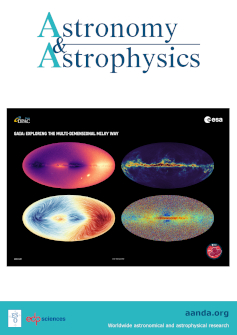L星系潮汐扰动事件的人口统计数据
IF 5.4
2区 物理与天体物理
Q1 ASTRONOMY & ASTROPHYSICS
引用次数: 0
摘要
在大质量黑洞(MBH)附近,恒星会被潮汐力撕裂,引起发光耀斑,即潮汐破坏事件(TDEs)。这些事件可能会导致中等质量黑洞的质量增长。来自瞬态巡天的新样本可以为这一尚未探索的增长通道提供有用的信息。这项工作的目的是通过在宇宙学框架内模拟 MBHs 及其星系环境的共同演化来研究 TDEs 的人口结构。我们使用半解析星系形成模型 L-Galaxies BH,该模型不仅跟踪星系的演化,还跟踪 MBH 的演化,包括 MBH 种子和生长、自旋演化和双 MBH 动力学的多种情景。我们根据用 PHASEFLOW 解决的一维 Fokker Planck 方程的解,将与恒星环境有关的时间相关的 TDE 率与每个 MBH 联系起来。我们的模型产生的体积速率与最新的光学样本和以前的 X 射线样本一致。这种一致性要求具有 MBHs 的核星团具有较高的占据率,因为在所有质量范围内,这些恒星库都承载着大多数 TDEs。我们预测,TDE速率是MBH质量的递增函数,最高可达105.5 M⊙,之后分布趋于平缓,并最终在> 107 M⊙时下降。一般来说,在 z z = 0 时,体积率被预测为与红移无关,这就解释了为什么在这些系统中 TDEs 是罕见的。这凸显了任何模型要想在所有质量范围内与观测结果保持良好一致,与时间相关的TDE速率是多么重要。本文章由计算机程序翻译,如有差异,请以英文原文为准。
Demographics of tidal disruption events with L-Galaxies
Stars can be ripped apart by tidal forces in the vicinity of a massive black hole (MBH), causing luminous flares known as tidal disruption events (TDEs). These events could be contributing to the mass growth of intermediate-mass MBHs. New samples from transient surveys can provide useful information on this unexplored growth channel. This work aims to study the demographics of TDEs by modeling the coevolution of MBHs and their galactic environments in a cosmological framework. We use the semianalytic galaxy formation model L-Galaxies BH, which follows the evolution of galaxies as well as of MBHs, including multiple scenarios for MBH seeds and growth, spin evolution, and binary MBH dynamics. We associated time-dependent TDE rates with each MBH depending on the stellar environment, following the solutions to the 1D Fokker Planck equation solved with PHASEFLOW. Our model produces volumetric rates that are in agreement with the latest optical and previous X-ray samples. This agreement requires a high occupation fraction of nuclear star clusters with MBHs since these star reservoirs host the majority of TDEs at all mass regimes. We predict that TDE rates are an increasing function of MBH mass up to ∼105.5 M⊙, beyond which the distribution flattens and eventually drops for > 107 M⊙. In general, volumetric rates are predicted to be redshift independent at z < 1. We discuss how the spin distribution of MBHs around the event horizon suppression can be constrained via TDE rates and the average contribution of TDEs to the MBH growth. In our work, the majority of low-mass galaxies host nuclear star clusters that have their loss-cone depleted by z = 0, explaining why TDEs are rare in these systems. This highlights how essential time-dependent TDE rates are for any model to be in good agreement with observations at all mass regimes.
求助全文
通过发布文献求助,成功后即可免费获取论文全文。
去求助
来源期刊

Astronomy & Astrophysics
地学天文-天文与天体物理
CiteScore
10.20
自引率
27.70%
发文量
2105
审稿时长
1-2 weeks
期刊介绍:
Astronomy & Astrophysics is an international Journal that publishes papers on all aspects of astronomy and astrophysics (theoretical, observational, and instrumental) independently of the techniques used to obtain the results.
 求助内容:
求助内容: 应助结果提醒方式:
应助结果提醒方式:


